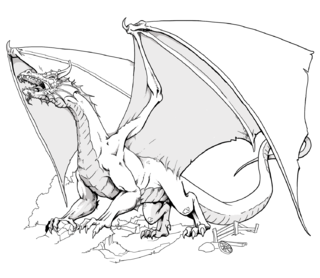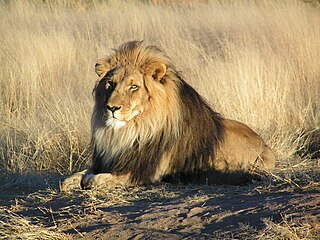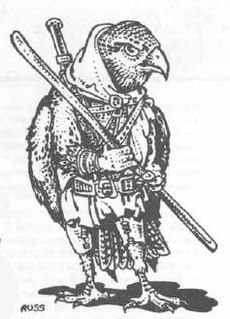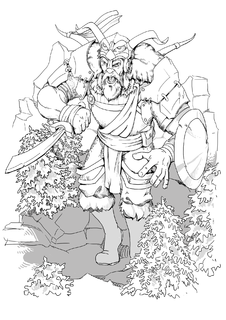Dracotaur
In the Dungeons & Dragons fantasy role-playing game, the dracotaur is a dragon. They are sort of a dragon-centaur, having the upper body of a reptilian humanoid and the lower body of a dragon. They are nomadic hunter-warriors who practice sorcery and occasionally serve true dragons.

In the Dungeons & Dragons (D&D) fantasy role-playing game, dragons are an iconic type of monstrous creature. As a group, D&D dragons are loosely based upon dragons from a wide range of fictional and mythological sources.

A centaur, or occasionally hippocentaur, is a mythological creature from Greek mythology with the upper body of a human and the lower body and legs of a horse. Centaurs are thought of in many Greek myths as being as wild as untamed horses, and were said to have inhabited the region of Magnesia and Mount Pelion in Thessaly, the Foloi oak forest in Elis, and the Malean peninsula in southern Laconia. Centaurs are subsequently featured in Roman mythology, and were familiar figures in the medieval bestiary. They remain a staple of modern fantastic literature.
The sorcerer is a playable character class in the Dungeons & Dragons fantasy role-playing game. A sorcerer is weak in melee combat, but a master of arcane magic, generally the most powerful form of D&D magic. Sorcerers' magical ability is innate rather than studied.
Dracotaurs are large creatures which have the upper torso of a muscular reptilian humanoid, and the lower, quadrupedal body of a wingless dragon. Their eyes are black, their feet large and clawed, and their sharp teeth glisten.
The favored class of the dracotaur is the sorcerer. Dracotaur barbarians, fighters, and rangers are also common. Dracotaurs are not overly religious, with clerics of them being rare. If not, however, Dracotaurs worship Tiamat. They speak Draconic.
The barbarian is a playable character class in the Dungeons & Dragons fantasy role-playing game. The class was introduced in 1985 and went through a number of evolutions in subsequent editions of the game.
The fighter is one of the standard playable character classes in the Dungeons & Dragons fantasy role-playing game. A fighter is a versatile, weapons-oriented warrior who fights using skill, strategy and tactics.
The Ranger is one of the standard playable character classes in most editions of the Dungeons & Dragons fantasy role-playing game. Rangers were hunters and skilled woodsmen, and often lived reclusive lives as hermits.
Half-Dragon
| Half-dragon |
|---|
| Information |
|---|
| Type | Dragon |
|---|
| Alignment | Varies due to dragon parent's alignment |
|---|
Half-dragons are fictional creatures in the Dungeons & Dragons fantasy roleplaying game.
A dragon's magical nature allows it to breed with virtually any species. This sort of conception usually happens when a dragon has been polymorphed or had its form changed in some way. Metallic half-dragons are usually kind except when abused by the common races in the game which will turn half-dragons away from all others except from its kin; those based on evil chromatic dragons often mirror their progenitor's outlook. Half-dragon's features are reptilian, with scales, horns, elongated faces and exaggerated teeth and claws. All have wings.
When engaged in combat half-dragons are formidable creatures and can be nearly invulnerable to weak adventurers. All Half-Dragons have a breath weapon according to their variety. Gold, Red and Brass spew fire. Bronze and Blue breathe lightning. Black, Green and Copper exhale acid and corrosive gas. Silver and White dragons blow extremely frigid air and ice. In addition all half-dragons have a special immunity towards the element of their breath weapon. There are exceptions to this for different dragon types. For example, the Deep Dragon of the Forgotten Realms setting has a Corrosive Acid gas breath weapon, but has a Charm immunity rather than an acid immunity.
The accessory, Races of the Dragon , has information on playing a half-dragon character, making half-dragons based on other dragon types (such as the dragons of the Oriental Adventures or Forgotten Realms campaign settings or the planar dragons of the Draconomicon ), and creating draconic creatures (which have some amount of dragon blood in their family, but not a dragon parent).
Spawn of Tiamat
| Spawn of Tiamat |
|---|
| First appearance | Monster Manual IV |
|---|
| Information |
|---|
| Type | Varies |
|---|
| Alignment | Evil |
|---|
Spawn of Tiamat are the progeny of Dragons, though not themselves of the Dragon type. They are the main object in a theme recently applied to such settings as Eberron and the Forgotten Realms, in that Tiamat, the evil patron goddess of evil dragons, is waging war against Bahamut, and the mortal races. In order for her legions to be more effective, she has tweaked with the eggs of her Dragon minions to produce all manner of bizarre draconic creatures suited to special roles in the war, such as assassination, bodyguarding, elite shock trooping, and aerial/aquatic support.
Spawn of Tiamat are created by all manner of experiments and rituals and such upon the eggs, come in all shapes and sizes and forms, are of varying intelligence levels, perform all manner of roles, and are basically the most varied members of dragonkind. All however, are descended from true dragons serving Tiamat, and are fiercely loyal to both her and their parents. Spawn of Tiamat are named according to the color they and their parent are of, followed by the word spawn, and then the type of spawn they are. The creatures are the key elements in the Monster Manual IV, and the recent War of the Dragon Queen D&D miniatures pack. Below is a list of the known types of spawn of Tiamat, and a brief description of each:
Blackspawn Raider
These are created in large hordes to act like draconic ogres, minotaurs, orcs, goblins, lizardfolk and such. They gather in groups at camps on the fringes of civilization, and occasionally raid against a town or village. They look like wingless, orc-sized, humanoid black dragons with minotaur-like horns. They are often depicted with large swords or axes.
Blackspawn Stalker
These resemble spider-like black dragons. They have two sets of horns, razor-sharp teeth, 6 eyes, 8 legs, bloated abdomens, no wings, and two tails which can weave silk.
Bluespawn Ambusher
These perform, as their name suggests, the role of ambushing people. They lurk beneath the sand of their desert homes, or on top of a rock, and then leap forward like a pouncing lion and kill victims with their horn, claws, and lightning attacks. They resemble medium, wingless blue Dragons with leonine bodies. They have huge front legs for attacking, and long, muscular back legs for leaping.
Bluespawn Burrower
These resemble marmot-like, wingless Blue dragons with enormous front legs, paws and claws. As their name implies, their role is digging and tunneling.
Bluespawn Godslayer
These are designed for slaying Tiamat's most powerful foes and adversaries. They are created from the placing of her blessing upon one of her most trusted blue Dragon lieutenants. They resemble giant, wingless, humanoid blue Dragons who always carry a huge blade and an arm-length shield made from a Dragon's skull. They are very intelligent, extremely strong, and fanatically loyal behemoths. They are probably the most famous of the Spawn of Tiamat.
Bluespawn Stormlizard
These resemble wingless blue dragon-like rhinoceri. From their stubby front horn, they can cast lightning so powerful it can, as the creature's name suggests, create storms.
Greenspawn Leaper
These resemble fiendish, sugarglider-like green dragons. They have web-like wings between their limbs, and they specialize in leaping from trees, gliding, and ambushing victims from above.
Greenspawn Razorfiend
These resemble lanky, crested, humanoid green Dragons with wings growing from their arms and fingers the way those of a bat do. They live in swampy forests.
Greenspawn Sneak
These specialize in assassination, sabotage, spying and the like. They resemble tiny, very silent and stealthy, wingless, humanoid green dragons. They are often depicted with twin blades, and black leather armor.
Redspawn Arcaniss
These are the spellcasters of the spawn of Tiamat. They are extremely skilled at casting magic and spells, particularly ones associated with fire. They resemble humanoid, wingless red Dragons with crested, spiked heads and tails. They are depicted with spiked body armor, and a bronze, mace-like wand.
Redspawn Firebelcher
These resemble large, chubby, round, short-tailed wingless red dragons with bloated stomachs. They dwell in the lairs of true red dragons, and bask on the banks of pools of molten lava the way seals do on beaches. They attack, as their name suggests, by inhaling heat from the air, and then belching it out in enormous blasts of flame.
Whitespawn Berserker
These resemble fiendish, lanky, jointed, wingless, alien-like white Dragons. As their name suggests, they specialize in fighting with two weapons, usually a pair of spiked, serrated whips.
Whitespawn Hordeling
These specialize in overwhelming opponents. They resemble small, wingless, monkey-like white dragons who carry twin weapons and breath shards of ice. They always travel in huge groups, which attack in unison.
Whitespawn Iceskidder
These resemble bluish-white dracotaurs with claws like skis and sail-like wings attached to their arms. As their name suggests, they specialize in traveling on ice, using their claws as skates and their wings for direction.















